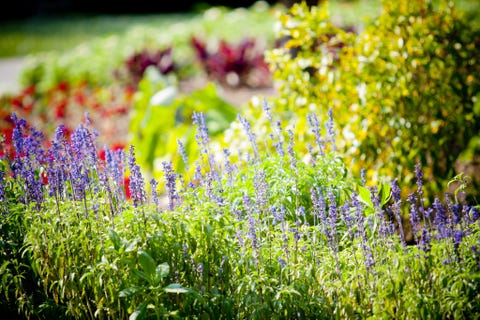
Viki Reed – Flickr
It’s not too late to add a splash of color to your garden. If you didn’t get your bulbs planted in the fall, don’t worry. You can still get some plants going this spring. Assuming your ground has thawed or you are using planters, these plants are perfect for planting in the spring, and will fully blossom just in time for the warm summer weather.
Arrange Your Plants
Before selecting your plants, take some time to arrange your garden or planters. Instead of planting in straight lines, stagger your plants in a slight zigzag pattern. They’ll actually absorb sunshine and water more evenly if they’re out of each other’s way, says Mary Moss-Sprague, Master Gardener and author of Stand Up and Garden: The no-digging, no-tilling, no-stooping approach to growing vegetables and herbs.
If you’ve got space, mix ornamentals and vegetables throughout your garden instead of dividing them into separate sections. You’ll save time and take advantage of companion planting. Examples include: garlic planted near roses helps keep the aphid population in check; radishes alongside spinach will keep the leaf miners away; tall flowers provide shade for lettuce.
Another helpful tip is to create microclimates in your garden by grouping plants together by shade, sun, water, and fertilizer needs. You’ll use less water and be able to maintain all the plants in one section at the same time rather than running to the four corners of your garden.
Select Spring Flowers
Native plants will grow better and with less fuss than a nonnative; they’re acclimated to where you live and usually need less care. Check your local nursery can provide a list of plants native to your area.
When selecting ornamental flowers, annuals may seem like the obvious choice—you buy them at the beginning of the season and throw them out when it’s over. But because annuals typically aren’t native plants, they tend to need more water and fertilizer, which means more work for you. Perennials, on the other hand, will do better and need less maintenance, and you don’t have to replant every season. Examples of easy-to-plant perennials are bear’s breeches, hostas, and red-hot pokers.
A great spring project is replacing all or part of your lawn with a no-maintenance ground cover, such as white clover. Moss-Sprague says it will take a beating and is a good choice if you need an area where the kids and animals can run around. Scotch moss, Corsican mint, mondo grass and blue star creeper can all be walked on without a problem as well. Ornamental grasses are another good choice. Try pachysandra, which grows well in shaded areas.
Choose Spring Vegetables
Herb and vegetable gardens are perfect for planting in the spring. You can enjoy their offerings just in time for your first summer bbq. Choose vegetables that you can seed directly into the ground or into containers, such as peas, beans, radishes, carrots, lettuce, and swiss chard. All are great growers that require minimal maintenance. Tomatoes can be picky when they’re young. You’re better off buying starters from a reliable supplier instead of seeding your own. Buy indeterminate varieties—they keep fruiting for as long as they want, whereas determinate varieties put out a fixed number and then call it quits.
Some plants, such as asparagus and rhubarb, and some herbs, such as mint, oregano, and parsley, just keep growing year after year. Look for varieties that will overwinter so you don’t have to replant each season. “There are a lot of new breeds coming out that are hardier, bred for cold winters,” Moss-Sprague says.
Not-so-easy choices: roses, grapes, cane berries, raspberries, and blackberries, which all require pruning to fruit well the following season.
Dwarf shrubs are easier to maintain because they won’t get tall enough to make pruning and maintenance difficult (although some can reach up to 6 feet, they take a very long time to grow to that height). There are many types to choose from, including hollies, boxwoods, rhododendrons, and aspidistra, with more new dwarf varieties being released each season. Euonymus is a good choice. “It adds a lot of pizzazz in the garden but doesn’t require a lot of shaping and trimming to keep it under control,” Moss-Sprague says.



